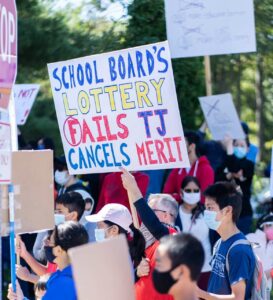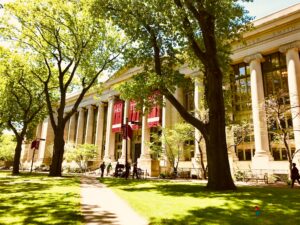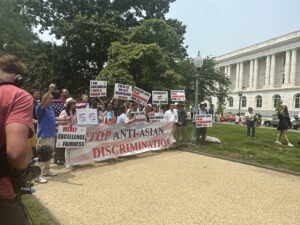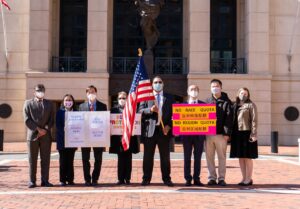The Supreme Court says students should be judged by merit, not race
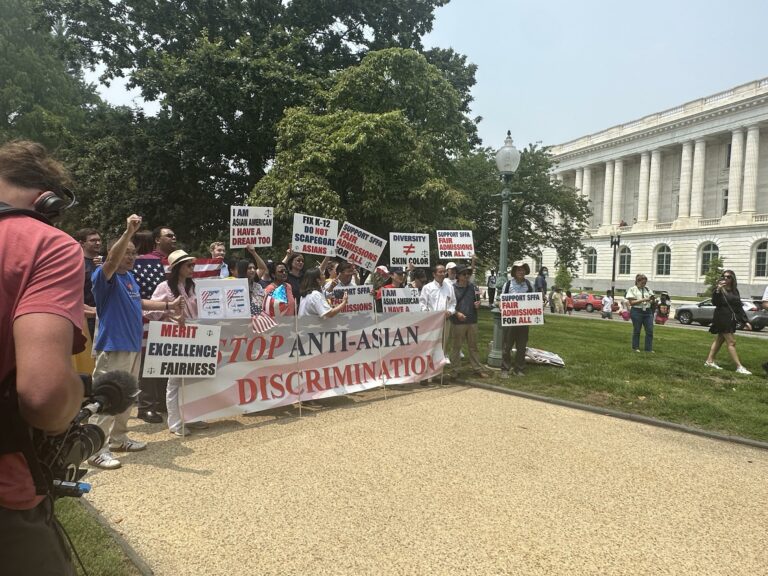
The Supreme Court’s joint ruling in Students for Fair Admissions v. Harvard and Students for Fair Admissions v. UNC is a huge win for racial equality.
Both cases challenged the respective universities’ admissions policies, which gave preferential treatment to some races over others. Students for Fair Admissions (SFFA) argued this practice is incompatible with the Fourteenth Amendment’s Equal Protection Clause, which promises that every individual will be judged by their individual merit, not by their race.
In a 6-3 vote, the Supreme Court agreed.
In the majority opinion, Chief Justice John Roberts wrote:
“The entire point of the Equal Protection Clause is that treating someone differently because of their skin color is not like treating them differently because they are from a city or from a suburb, or because they play the violin poorly or well. ‘One of the principal reasons race is treated as a forbidden classification is that it demeans the dignity and worth of a person to be judged by ancestry instead of by his or her own merit and essential qualities’ (Rice). But when a university admits students ‘on the basis of race, it engages in the offensive and demeaning assumption that [students] of a particular race, because of their race, think alike’ (Miller).”
For years, Harvard’s admissions process has had a disproportionate impact on Asian applicants. In fact, the school’s routine use of anti-Asian discrimination was so well-known, the college prep organization Princeton Review even counseled Asian students to withhold any information from their applications that would appear too Asian. This included the desire to study mathematics and medicine.
While both schools claimed these policies would contribute to the racial harmony of the student body, all it does is punish one minority group in exchange for another.
In his concurrence, Justice Clarence Thomas wrote:
“Given the history of discrimination against Asian Americans, especially their history with segregated schools, it seems particularly incongruous to suggest that a past history of segregationist policies toward blacks should be remedied at the expense of Asian American college applicants.”
Harvard and UNC asserted that their processes were consistent with the 20-year-old precedent established in Grutter v. Bollinger. The Grutter decision permitted colleges to screen highly qualified applicants on the basis of race, allegedly for the legitimate government interest of maintaining a particular racial mix in their student body.
But that ruling is now overturned.
Justices Elena Kagan, Ketanji Brown Jackson, and Sonia Sotomayor dissented.
Justice Sotomayor wrote:
“At bottom, the six unelected members of today’s majority upend the status quo based on their policy preferences about what race in America should be like, but is not, and their preferences for a veneer of colorblindness in a society where race has always mattered and continues to matter in fact and in law.’
Justice Jackson also took issue with the majority:
“The Court has come to rest on the bottom-line conclusion that racial diversity in higher education is only worth potentially preserving insofar as it might be needed to prepare Black Americans and other underrepresented minorities for success in the bunker, not the boardroom (a particularly awkward place to land, in light of the history the majority opts to ignore). It would be deeply unfortunate if the Equal Protection Clause actually demanded this perverse, ahistorical, and counterproductive outcome. To impose this result in that Clause’s name when it requires no such thing, and to thereby obstruct our collective progress toward the full realization of the Clause’s promise, is truly a tragedy for us all.”
But the dissents didn’t have the last word—because Chief Justice Roberts had harsh words for those dissenting.
He wrote:
“Most troubling of all is what the dissent must make these omissions to defend: a judiciary that picks winners and losers based on the color of their skin. While the dissent would certainly not permit university programs that discriminated against black and Latino applicants, it is perfectly willing to let the programs here continue. In its view, this Court is supposed to tell state actors when they have picked the right races to benefit. Separate but equal is ‘inherently unequal,’ said Brown. It depends, says the dissent.”
Justice Thomas also pointed out:
“… these policies appear to be leading to a world in which everyone is defined by their skin color, demanding ever-increasing entitlements and preferences on that basis. Not only is that exactly the kind of factionalism that the Constitution was meant to safeguard against, see The Federalist No. 10 (J. Madison), but it is a factionalism based on ever-shifting sands.”
On the basis of merit, not race
Pacific Legal Foundation is committed to fighting for equality before the law for everyone—regardless of skin color. We proudly supported SFFA and filed an amicus brief on their behalf in both the Harvard and UNC cases because we believe that using racial identity, rather than individual merit, when considering a student for admissions is not only wrong, it’s also constitutionally prohibited.
Not everyone agrees with us.
Less than an hour after the ruling was released, demonstrations erupted in front of the Supreme Court.
On one side stood the Coalition for TJ—a group of parents, students, and alumni who are currently in a legal battle of their own against similar discriminatory admissions policies being used at the Virginia-based Thomas Jefferson High School for Science and Technology (TJ), the top public high school in the country.
In response to the 2020 death of George Floyd, the Fairfax County School Board substituted its rigorous, merit-based admissions policies in favor of a “holistic” approach that would promote equity over equal opportunity.
While the school claimed that the new policy would make the school more diverse, the ugly truth behind this change was that it was designed specifically to target prospective Asian American students. And this wasn’t just speculation, as the evidence clearly shows. The first year the new admissions policy went into effect, the number of Asian American students at TJ dropped by 16%.
In opposition to the Coalition for TJ, a group of protestors carried signs disagreeing with the Court’s decision and supporting affirmative action.
While no physical violence broke out, tensions were high as the affirmative action crowd attempted to drown out the Coalition for TJ with loud music and a megaphone. Led by its cofounder Asra Nomani, the Coalition continued to celebrate the victory despite the attempts to silence their voice. As the music got louder and the megaphone got closer, Coalition members did their best to block the counter protesters with signs that read “Help Students in Need Regardless of Race” and “Support Fair Admissions for All.”
For TJ parents, the fight for racial equality in school admissions is far from over.
Represented by Pacific Legal Foundation, the Coalition sued the school board in 2021. While the district court ruled in the Coalition for TJ’s favor initially, the school board appealed. In May, the U.S. Court of Appeals for the Fourth Circuit ruled that TJ’s admissions process was not discriminatory.
But Coalition members have not given up. PLF will be asking the Supreme Court to hear their case in the coming months.
The Court’s decision has given Coalition for TJ parents a great deal of hope. The court has established that under the Fourteenth Amendment, racial discrimination is wrong. This is just as true in K-12 school as in universities, and it’s just as true when proxies for race are used instead of explicit racial categories, as in the TJ case.
The TJ and Harvard cases are not identical, but they both ask that schools receiving public funding judge students on the basis of individual merit, not race. Yesterday’s ruling could help pave the way for a TJ victory at the Supreme Court.
This is a step in the right direction, and there are many reasons to celebrate.
To echo Justice Thomas’ closing remarks in his concurrence:
“I hold out enduring hope that this country will live up to its principles so clearly enunciated in the Declaration of Independence and the Constitution of the United States: that all men are created equal, are equal citizens, and must be treated equally before the law.”







